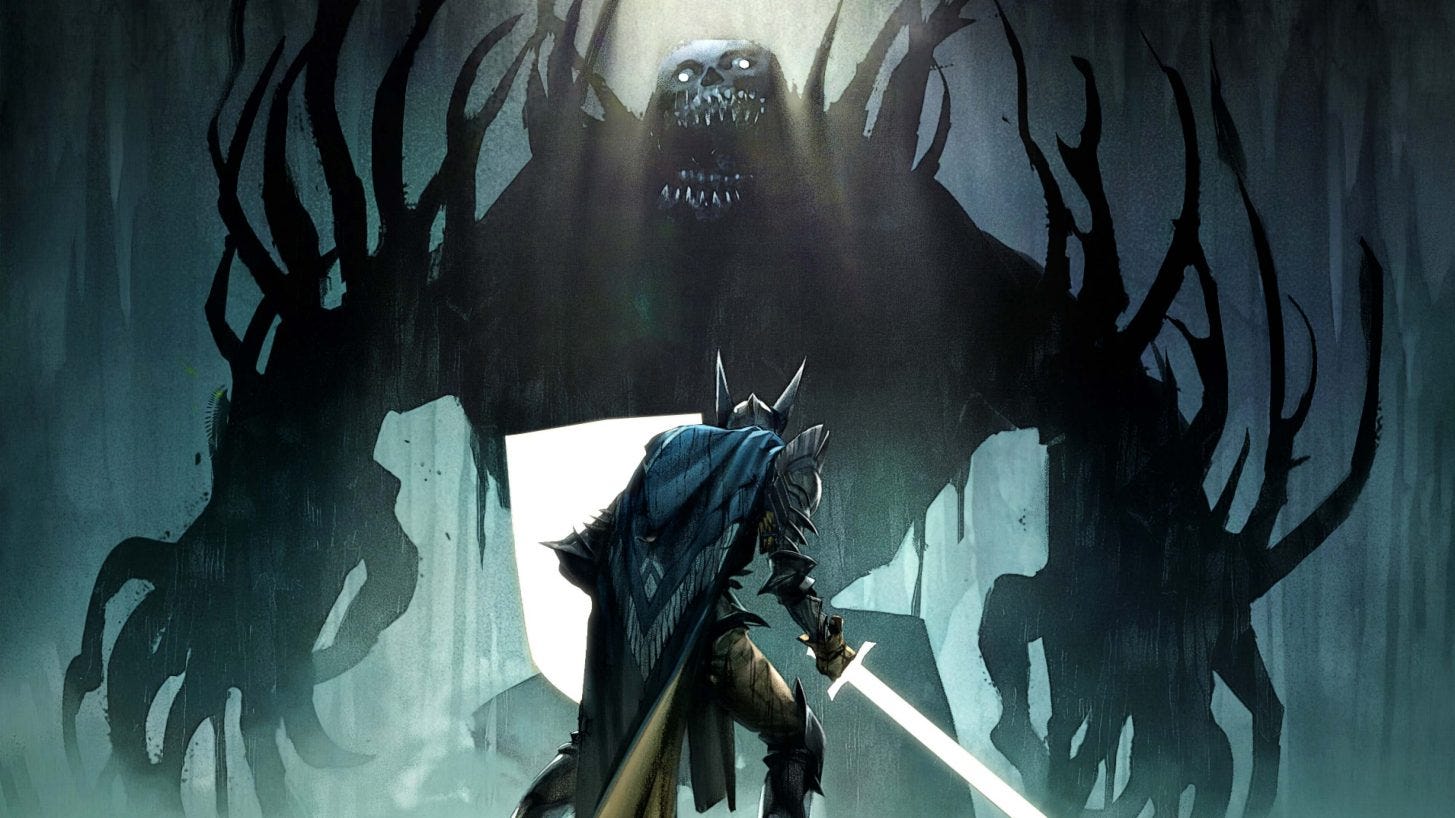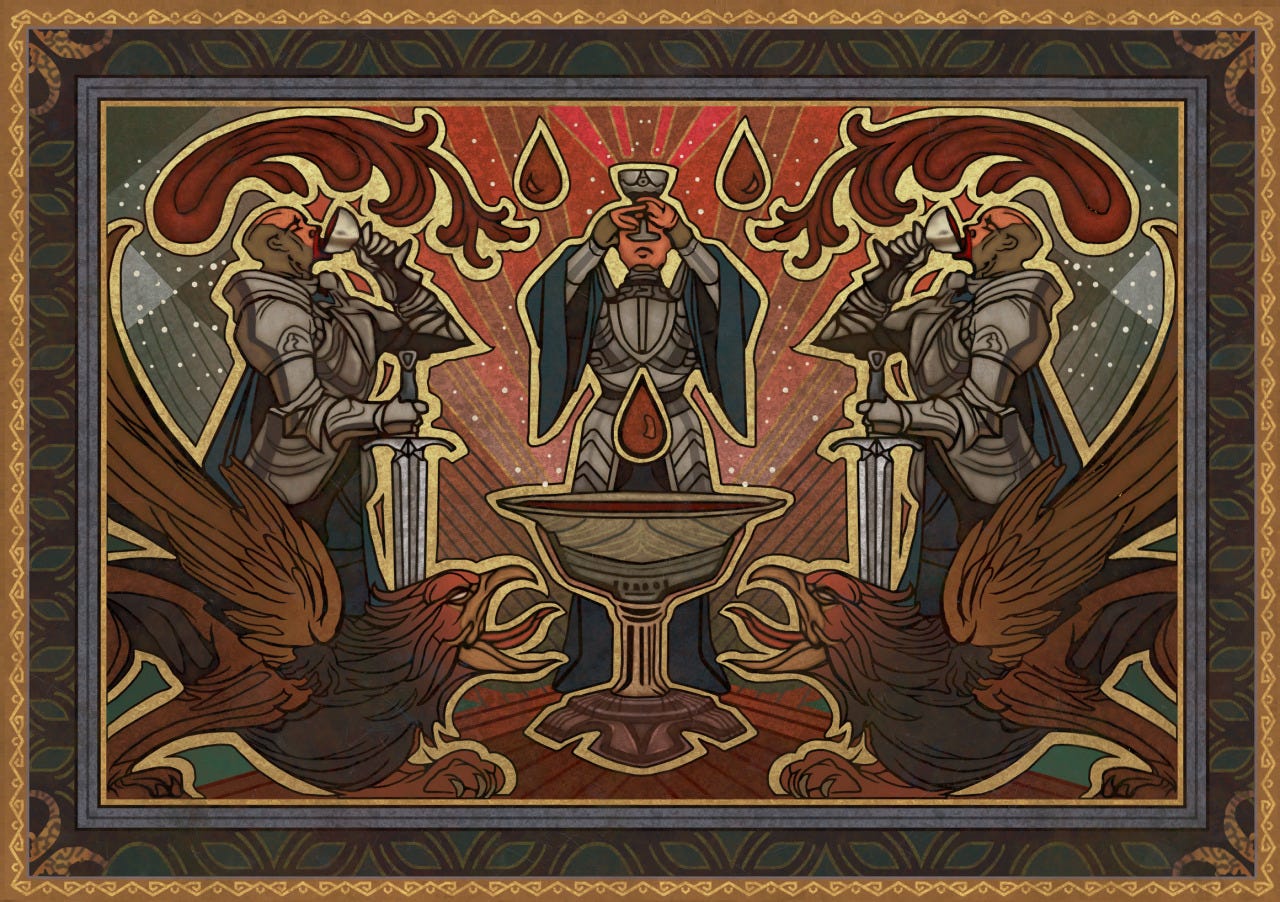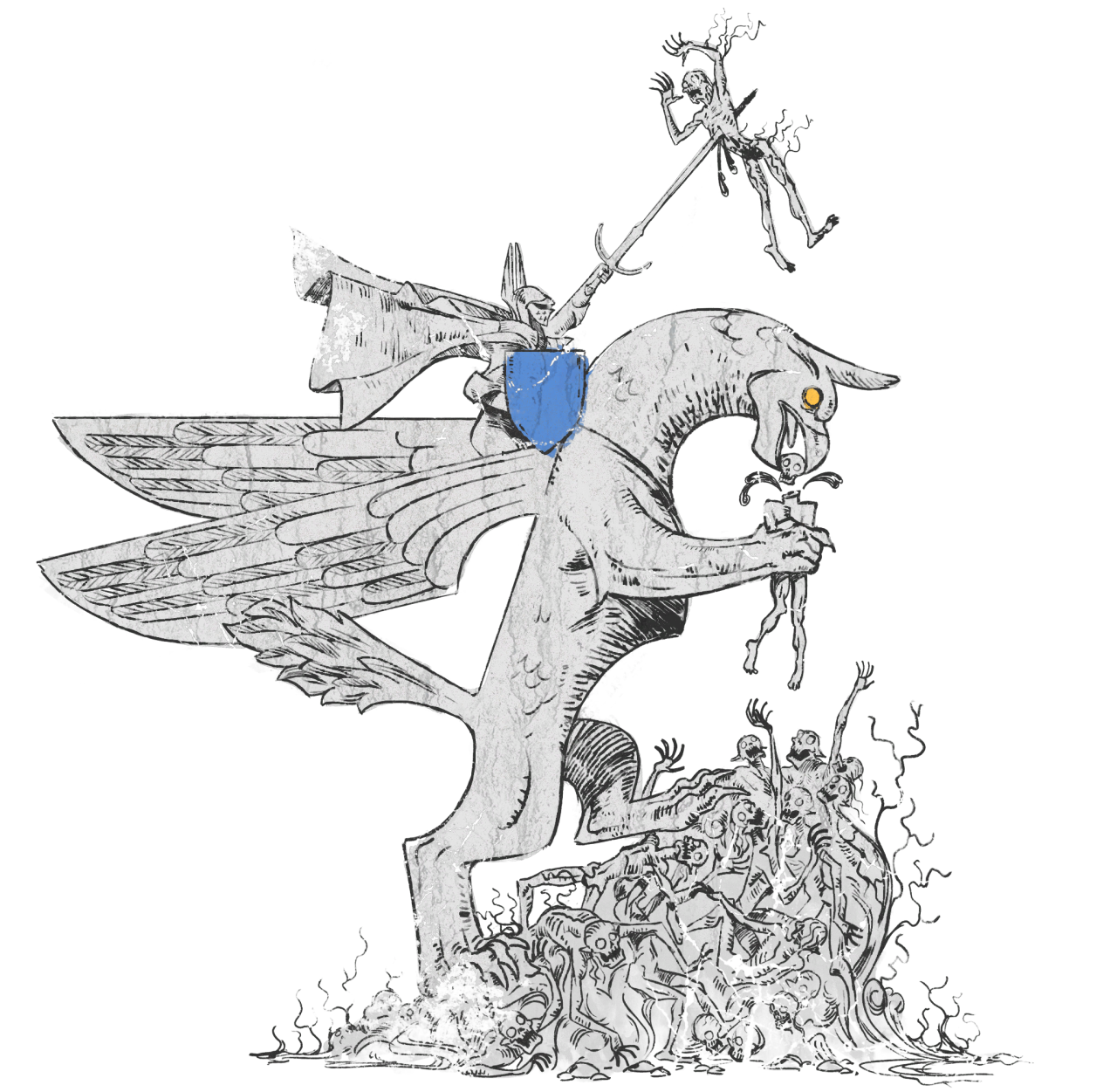Spoiler warning for Dragon Age: Origins and Dragon Age: The Veilguard.
Around halfway through Dragon Age: The Veilguard, you find yourself in a quiet chamber. There’s not much to see here — some books, an elevator at the end of the hall, and a cup sitting on a pedestal. This space is liminal, just meant to give you a second to catch your breath before heading into the next fight.
But it was here that I had the most impactful and emotional moment of the entire game.
That cup made me cry.
If you’re unfamiliar with Dragon Age, it may come as a surprise to learn that dragons aren’t all that important in the games. Instead, the backbone of the series is a corruption known as the blight.
The blight acts like a fungal rot, creating a hivemind of infected people, places, and even dragons. This corruption can manifest “outbreaks” — where hordes of zombie-like darkspawn wash over the world, led by a seemingly-immortal blighted dragon called an Archdemon.
You learn all of this within two minutes of starting the first game in the series, Dragon Age: Origins, just before it goes on to tell you about the Grey Wardens, a secretive group that defends against the blight.

Dragon Age has been pretty restrained in how much you see of the Wardens, even though you play as one in Origins. Throughout the series, we only encounter the scattered, dying remains of an order susceptible to corruption; we only hear tales and see the occasional flash of its lost grandeur.
In Origins, you are introduced to the Grey Wardens on the eve of battle in Ostagar, a ruined fortress. To join the order, you and two other prospective Grey Wardens go through the Joining ritual, during which you drink darkspawn blood from a silver chalice. The ritual has a high mortality rate, and even those who survive will be killed by it eventually — having tainted blood allows Wardens to sense the blight and fight it more effectively, but its corruption can’t be resisted forever.
Suddenly, the order’s motto makes a lot more sense: “In War, Victory. In Peace, Vigilance. In Death, Sacrifice.”
Of the three that go through the Joining in Ostagar, only one survives. The battle itself is a bloodbath, leaving only you and another junior Warden alive.
Later, you can return to the ruins and salvage what little remains — including the Joining Chalice. With the Wardens in the area decimated, it’s one of your last connections with the order.

“Darkspawn blood still encrusts this silver chalice. With a shudder, you remember the day you brought it to your lips and drank deeply of all the mysteries that lay within.”
— Joining Chalice item description, Dragon Age: Origins
Veilguard is the first game since Origins that allows you to play as a Grey Warden. Going into it, I was interested to see how much my character would feel like a member of the order. Honestly, my hopes weren’t very high. There are five other faction options, and making each of them significantly impact the game is a lot of work. Boy, was I wrong to doubt.
As expected, being a Warden gives your character (nicknamed Rook) new banter and dialogue options related to the blight and Wardens. But where previous games often fell a bit short, Veilguard’s character-specific dialogue is much more abundant and impactful.

Early on, you encounter a mayor who allowed his village to be blighted and, only if Rook is a Warden, you are given the option to send him to join the order. Later, when you meet up with the Wardens in a new area, the man is not only present — he changes the trajectory of a side quest and reacts to events throughout the rest of the game.
But what really surprised me was Rook’s relationship with other Warden NPCs. When you seek out the Grey Wardens as part of the main questline, you don’t meet a faceless representative, but your friends Antoine and Evka. When you do encounter Wardens you’ve never met before, there’s still a sense of familiarity and shared experience. And when you’re eventually at odds with the head of the order, the First Warden dislikes you all the more because of your somewhat reckless past.
While playing Origins, it’s hard not to feel impostor syndrome as you run around claiming to be a Grey Warden. Yes, you’ve gone through the Joining, but Ostagar denied you the opportunity to really feel like a part of it all. Even the battle, which is an amazing narrative moment, rings a bit hollow because you aren’t given much of a chance to connect with the Wardens before everything falls apart.
One thing Dragon Age fans have wanted since Origins released in 2009 is to visit Weisshaupt, the fortress that serves as the Grey Wardens’ headquarters — Veilguard finally grants that wish.
While investigating changes to the blight and the return of ancient elven gods, Rook receives word that the First Warden is calling all members of the order to Weisshaupt to face an incoming horde of darkspawn. Of course, your ragtag group of heroes rushes to join the fight, but defending the fortress is technically secondary to your larger goal of striking down the Archdemon leading the army and killing the blighted god it serves.
When you arrive, the siege has already begun.
Weisshaupt crumbles under giant tendrils of the blight, and the young daughter of a blacksmith tells you that darkspawn are scaling the outer wall. You fight your way toward the war room, knowing that the worst is yet to come.
Along the way, you push open a door only to come face-to-face with roiling clouds shaping themselves into the impossibly tall face of the god you hunt. Before you even have a chance to react, the Archdemon appears, a once-apocalyptic threat now dwarfed by its master.
On top of their raw destructive power, Archdemons also have control over the blight, including that which resides in every Warden. For now, this just manifests as a splitting headache.
Finally, you reach the war room and piece together a last-ditch plan to use an untested dragon trap to capture and kill the Archemon — it’s a long shot, but it’s all you’ve got.
And then you’re off again, fighting your way to the other side of Weisshaupt as Wardens die all around you. The next fights are grueling — each spark of hope is quickly extinguished, each path forward is rerouted. It’s terrifying just how quickly a legendary fortress can be reduced to rubble.
Your various detours point you to the library. You fight darkspawn through ruined houses and markets, including the courtyard where a Grey Warden Rook went through their own Joining. It’s a startling reminder that this isn’t just a place built for war, but your home.
You move toward a ringing bell tower, the Wardens’ rallying point, until it is unceremoniously decapitated by the Archdemon flying through it. “Cold skins. Sinking hope. Your blood knows you’ll die here,” the god made of clouds says.
When you do reach the library, the door is locked.
Your back is against the wall, and still the darkspawn keep coming.
But just in the nick of time, your allies get the door open and quickly closed again. The plan is the same, though it was already risky when you came up with it. Now, it feels like suicide.
Even if your plan works, slaying an Archdemon claims the life of the Warden who strikes the killing blow — “In Death, Sacrifice,” remember?
And so, you find yourself in a quiet chamber. A place to catch your breath before heading into what could be your final fight. There’s not much to see here — some books, an elevator at the end of the hall, a cup sitting on a pedestal.
You can interact with a plaque beneath the cup, it says this:
This is what broke me. I read these six words and just started sobbing. Hopefully, I’ve communicated enough of the importance of that stupid cup and the stress of this moment that you don’t think I’m too crazy.
“You wondered how the Battle of Ostagar would’ve felt if you cared more about the people involved?” the Joining Chalice says. “This is what it feels like. This is what it means to be a Grey Warden.”
After the moment passes, you make your way through the library, which is crawling with blight. You can still skim through records of the Grey Wardens’ centuries-long history, books mentioning characters and events from throughout the series — another reminder of everything that depends on what comes next.
Things get worse from here, eventually forcing the Wardens to flee Weisshaupt. But not all is lost: they were able to rescue a few things too precious to leave behind.
Among them — now missing its plaque — is the Joining Chalice, once again pulled from the ruin of defeat.
“But still, there’s hope,” the Chalice says. “We’ve made it through this before, we’ll make it through again.”
This is just supposed to be about an innocuous cup in a video game, but you need to understand: the Joining Chalice isn’t in Veilguard for Rook or any other character in the game — it was put there for you, the player.
One of the most contentious aspects of Veilguard is its minimal options for porting your choices and characters from previous games. Bringing your story into a series’ next installment is a staple of BioWare games, so a lot of fans hated that only three choices carry over into Veilguard (all of which are from Dragon Age: Inquisition, the previous game).
Though I think it was ultimately for the best, I understand those who feel like their choices have been invalidated or overridden, and I know cameos or easter eggs will never make up for that. But for me, the Joining Chalice is an acknowledgment that Origins hasn’t been forgotten — that it mattered, even if including its choices and characters directly is outside of Veilguard’s scope.
The fact that we have Dragon Age: The Veilguard at all is surprising, considering the sheer number of challenges it faced during development. Many people left BioWare in the decade between Inquisition and Veilguard, including 50 who were laid off just two months before Veilguard’s release. Then, when the game undersold, the rest of the Dragon Age team was entirely dissolved — either moved to other projects or laid off.
The past two years have been difficult for the game industry, to say the least, but what happened to the Dragon Age team hit me especially hard. Inquisition is a big reason I became interested in game design in the first place. I dreamed of getting to work on a Dragon Age game one day. Now, Veilguard isn’t the beginning of a new chapter for the franchise, but its swan song.
I think it’s fitting, in retrospect, that the game puts you against terrible odds and asks you to remain hopeful — to believe that your efforts will make a difference, to stare down an impossible situation and say, “We’ve made it through this before, we’ll make it through again.”
Notes:
The game won’t actually let Rook be the one to strike the killing blow on the Archdemon, even if they’re a Warden. Regardless, for reasons complicated but cool lore reasons, the person who kills this Archdemon is fine.
Suggested Reading:
“The Next One” and “Won’t Know When” by Brianne Battye are two short stories about the Wardens — specifically Antoine and Evka, who I absolutely fell in love with while playing Veilguard.
If you want to learn more Dragon Age lore, I recommend checking out Ghil Dirthalen’s videos. She has quick overviews (both with and without spoilers), longer deep-dives, and all sorts of other great Dragon Age stuff.







